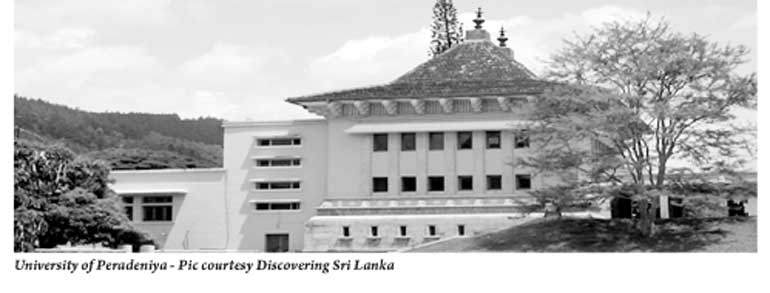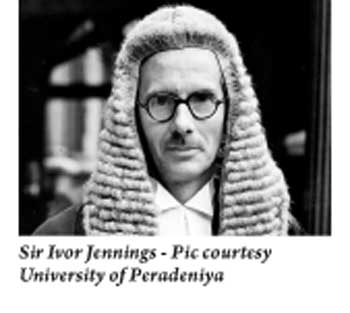Friday Mar 21, 2025
Friday Mar 21, 2025
Saturday, 25 November 2017 00:00 - - {{hitsCtrl.values.hits}}

By P.K. Balachandran
To mark the 75th anniversary of the degree-awarding university system in Sri Lanka this year, a group of old students of Peradeniya University have produced a coffee table book on their alma mater.
Authored by S.A.C. Mohamed Zuhyle and Dr. R.M.K. Ratnayake, the well-illustrated volume, with each picture carrying crisply-written notes, was released last Sunday by Minister of Higher Education Lakshman Kiriella.
With the Peradeniya University campus being rated as the 10th most beautiful campus in the world, the volume is aptly titled ‘Garden University of Peradeniya’. Set amidst sylvan surroundings and manicured gardens, the sprawling campus stands out also because it is uniquely Sri Lankan in its architecture.
The offices, teaching blocks and the halls blend neatly with the traditional Sri Lankan architecture of the Kandyan, Anuradhapura and Polonnaruwa periods in the island’s history.
As co-author Zuhyle put it, this is surprising given the fact that the moving spirit and executor of the university building project was Sir Ivor Jennings, an Englishman.
“Sir Ivor was a European, a White and a gentleman of the colonial era. One would expect him to favour the classical Greek or Roman styles. But he was of a different mould,” Zuhyle said.
A constitutional lawyer, who went on to help D.S. Senanayake draft a constitution for the Dominion of Ceylon, Sir Ivor was dedicated to the indigenisation of British-inspired institutions in Sri Lanka. He was the father of the university system in Sri Lanka having been the Principal of the University College of Ceylon, a non-degree awarding university institution in Colombo, and the founder Vice Chancellor of the University of Ceylon which came into being 75 years ago in 1942.
Sir Ivor was so passionate about the new university project that he would keep track of it and supervise it closely. Although Sir Patrick Abercrombie and Shirley D’Alwis, a Sri Lankan, were the architects, it was Sir Ivor’s concept which was translated into brick and mortar.
“He even chose the plants and trees in the campus,” Zuhyle said.
Interested in social uplift (having studied in Grammar Schools, where the less well-to-do British went), Sir Ivor wanted to establish an endowment in his name to help indigent but promising students of Sri Lanka.
Sir Ivor’s yearning was at the back of the minds of the authors of the coffee table book, Zuhyle and Ratnayake. They decided that the earnings from the sale of the book (priced at Rs. 3,000) should go into a ‘Sir Ivor Jennings Endowment Fund,’ which in turn will fund student development projects in Peradeniya University.
“We will concentrate on the development of soft skills, which are of utmost importance these days. Students coming out of universities may have academic achievements or technical expertise, but they lack soft skills which are necessary to secure employment in the modern economy,” Zuhyle said, explaining the need for student development projects in Sri Lanka.
‘Garden University of Peradeniya’ tells the story of the Peradeniya campus from the germination of the idea of having a university in the island way back in the 1920s to its inauguration in 1942.
The story is told through vignettes about the key personalities who shaped the university and nuggets of information on the various institutions in the campus.
“There are a number of books on the university, including one by Ivor Jennings himself, but we felt there is a need to bring out an easy to read book on a campus which has much to be proud of,” Zuhyle said.
 The slim volume could be used to promote tourism, he added. The beautiful university campus could well be included in tourists’ itinerary along with the Botanical Gardens and the Temple of the Golden Tooth in Kandy. The Government could buy copies for display in the country’s embassies overseas. The book also narrates in a readable form, the intense debate over the choice of a site for the university. In ‘Battle of Sites,’ the warring parties were drawn from the who’s who of the indigenous elite of colonial Ceylon. Among them were the Ponnambalam bothers – Ramanathan and Arunachalam; Sir James Peiris; Sir Marcus Fernando; Sir D.B. Jayatilake; and D.R. Wijewardene.
The slim volume could be used to promote tourism, he added. The beautiful university campus could well be included in tourists’ itinerary along with the Botanical Gardens and the Temple of the Golden Tooth in Kandy. The Government could buy copies for display in the country’s embassies overseas. The book also narrates in a readable form, the intense debate over the choice of a site for the university. In ‘Battle of Sites,’ the warring parties were drawn from the who’s who of the indigenous elite of colonial Ceylon. Among them were the Ponnambalam bothers – Ramanathan and Arunachalam; Sir James Peiris; Sir Marcus Fernando; Sir D.B. Jayatilake; and D.R. Wijewardene.
While some wanted the campus to be located in Colombo, given its facilities, centrality and connectivity, others wanted it to be located away from the hustle and bustle of the city to give scope for untrammelled contemplation, necessary for the development and nurturing of new thoughts and ideas expected of a university.
Given the intensity of the differences between the two schools of thought, the Government appointed a committee under Justice M.T. Akbar. Akbar chose Peradeniya near Kandy.
“Once Akbar let his preference be known, ranks were closed and every one cooperated to make the university a reality. The elite also contributed funds. And Sir Ivor went about his task of raising the campus on an abandoned tea estate with single-minded devotion,” Zuhyle said.
Writing ‘Garden University of Peradeniya’ was not easy. Getting the idea of producing a coffee table book accepted by the old students was a challenge as the concept was non-traditional. But Zuhyle’s perseverance and persuasive talking paid off in the end.
“There were other challenges too. Getting hold of people who could throw fresh light on the past was difficult. Collection of photographs was a harder task. We needed print quality pictures which were a rarity. Finally, I, who had no background of photography, took many of the pictures and discovered that I wasn’t a bad photographer!” Zuhyle said.
Discover Kapruka, the leading online shopping platform in Sri Lanka, where you can conveniently send Gifts and Flowers to your loved ones for any event including Valentine ’s Day. Explore a wide range of popular Shopping Categories on Kapruka, including Toys, Groceries, Electronics, Birthday Cakes, Fruits, Chocolates, Flower Bouquets, Clothing, Watches, Lingerie, Gift Sets and Jewellery. Also if you’re interested in selling with Kapruka, Partner Central by Kapruka is the best solution to start with. Moreover, through Kapruka Global Shop, you can also enjoy the convenience of purchasing products from renowned platforms like Amazon and eBay and have them delivered to Sri Lanka.
Discover Kapruka, the leading online shopping platform in Sri Lanka, where you can conveniently send Gifts and Flowers to your loved ones for any event including Valentine ’s Day. Explore a wide range of popular Shopping Categories on Kapruka, including Toys, Groceries, Electronics, Birthday Cakes, Fruits, Chocolates, Flower Bouquets, Clothing, Watches, Lingerie, Gift Sets and Jewellery. Also if you’re interested in selling with Kapruka, Partner Central by Kapruka is the best solution to start with. Moreover, through Kapruka Global Shop, you can also enjoy the convenience of purchasing products from renowned platforms like Amazon and eBay and have them delivered to Sri Lanka.